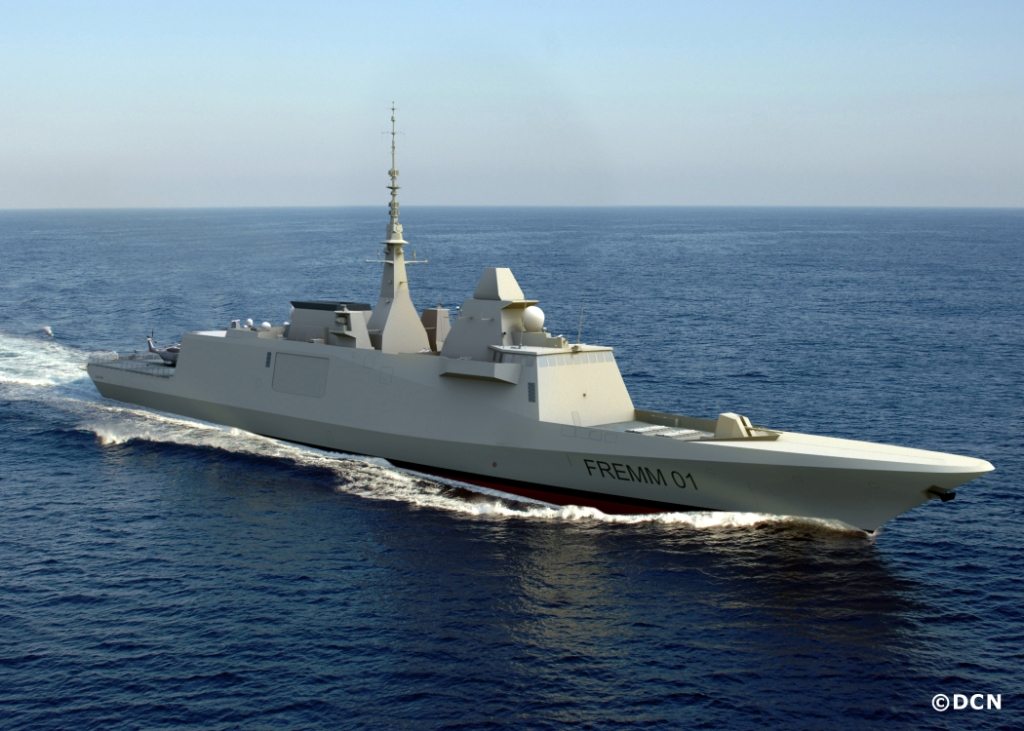France: On 12 July 2014, DCNS floated the FREMM multi-mission frigate Languedoc in Lorient, France. The achievement of this industrial milestone marks an important step in the construction of the vessel. It once again underlines the industrial dynamism of DCNS: five multi-mission frigates are under simultaneous construction, at different stages of advancement.
Today, on its Lorient site, DCNS floated the FREMM Languedoc, fourth of the series ordered by OCCAr on behalf of the French DGA (Direction Générale de l’Armement) and the French Navy.
The technical operations started in the morning with the floating of the construction frame. The different steps of the floating operation were continued over the course of the day, culminating in the frigate being moved out of its construction dock. Over the course of a manoeuvre that lasted about fifteen minutes, tug boats successfully guided the frigate to the quay on the DCNS site in Lorient, where its construction will continue.
“Over the coming months, the Group’s teams alongside the teams of its subcontractors will pursue the assembly and integration of the different systems on the FREMM Languedoc” explains Anne Bianchi, Director of the FREMM Program at DCNS. “The next major step will be the installation of the mast structures with the vessel’s main sensors (radars, antennas, cameras, radar jammers …). They will then be integrated into the latest-generation SETIS combat management system, developed by the Group.”
DCNS started the construction of the FREMM Languedoc, fourth of the series for the French Navy, in September 2011. This new-generation frigate will be operated by a streamlined crew of 108 sailors (i.e., half the number required for frigates of the previous generation).
The FREMM is capable of executing versatile anti-aircraft as well as anti-surface and anti-submarine warfare missions. The first multi-mission FREMM frigate, the Aquitaine, built for the French Navy, was accepted by OCCAr on 23 November 2012 on behalf of the DGA (Direction Générale de l’Armement. The second FREMM frigate, the Normandie, will be delivered at the end of 2014.
The FREMM program: a major program for DCNS and its partners
For DCNS, the FREMM program represents twelve units, with eleven for the French Navy and one for the Royal Moroccan Navy.
To recall, in November 2012, DCNS successfully delivered the FREMM Aquitaine, the first unit in the series of FREMM multi-mission frigates. The second unit in the program, the FREMM Mohammed VI, was delivered to the Royal Moroccan Navy on 30 January 2014.
DCNS is currently building five other multi-mission frigates in Lorient, all at different stages of advancement:
- – The FREMM Normandie, third unit in the series and the second for the French Navy, started its sea trials in October 2013 and will be delivered to the French Navy at the end of 2014;
- – The FREMM Provence was floated in September 2013 and will perform its first sea outing in the third quarter of 2014;
- – The FREMM Languedoc has just been floated;
- – 2 other FREMMs are currently under construction.
FREMM technical characteristics
FREMM frigates are extensively armed and are equipped, under the project management of DCNS, with the most capable weapon systems and equipment, such as the Héraclès multifunction radar, the Naval Cruise Missile, the Aster and Exocet MM 40 missiles or the MU 90 torpedoes.
- Overall length: 142 metres
- Width: 20 metres
- Displacement: 6,000 tonnes
- Maximum speed: 27 knots
- Crew: 108 persons (helicopter detachment included)
- Accommodation capacity: 145 men and women
- Range: 6,000 nautical miles at 15 knots
DCNS designs and builds submarines and surface combatants, develops associated systems and infrastructure, and offers a full range of services to naval bases and shipyards. The DCNS Group generates annual revenues of €3.4 billion and employs 13,600 people (2013 data).










